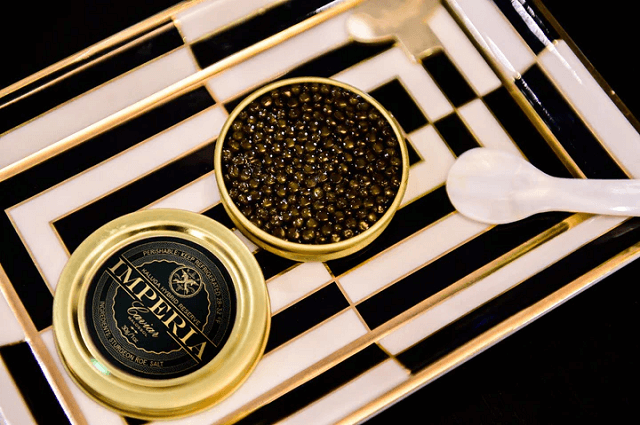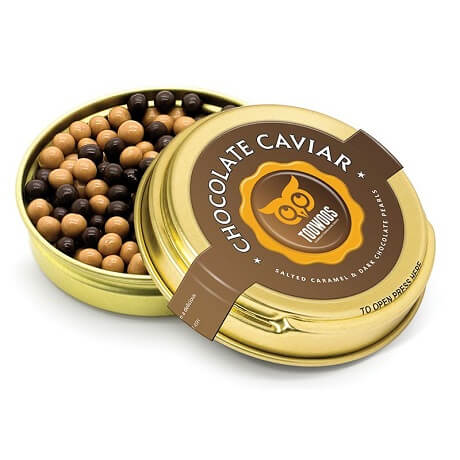Whether you’re trying to impress dinner guests or just indulging in a luxurious treat for yourself, there’s nothing worse than wasting even one precious pearl of this prized food.
If you’ve ever struggled with cracking the code of opening a caviar tin without damaging any pearls, fear not! In this blog post, we’ll share some expert tips and tricks to help you master the art of opening your next tin of caviar like a pro.
So sit back, grab your favorite drink, and get ready to learn how to savor every last bite of your caviar without any unnecessary waste.
Table of Contents
What Is Caviar?

Caviar is the traditional name for sturgeon eggs that have been salt-cured and then aged. The word “caviar” comes from the Persian word خاویار (khāviyār), which means “egg producer”.
Caviar is typically eaten as an hors d’oeuvre, with little crackers or blinis, and a shot of vodka. It can also be used in recipes, such as pasta dishes or omelets.
Caviar is a luxurious food and its price reflects that. However, it is possible to find affordable caviar that still tastes great. It just takes a little bit of research.
When buying caviar, look for tins that are clearly labeled with the type of fish eggs inside, the country of origin, and the date of production. Avoid tins that are dented, leaking, or otherwise damaged.
How to Open Caviar Tin Without Wasting Any Pearls

If you’ve ever tried to open a tin of caviar without wasting any pearls, you know it can be a challenge. The key is to have the right tools and to know the proper technique. Here’s how to open a tin of caviar without wasting any pearls:
First, make sure you have a sharp knife and a clean work surface. Caviar is delicate and easily damaged, so you don’t want to use a dull knife or cut on a dirty surface.
Next, find the seam that runs around the circumference of the tin. This is where the lid is attached to the body of the tin. Carefully insert your knife into this seam and begin gently prying the lid off. Be careful not to bend or dent the lid as you do this.
Once the lid is off, use your knife to remove any remaining bits of metal from the rim of the tin. These can be sharp, so be careful not to cut yourself.
Now it’s time to dig in! Use a spoon or fork to scoop out the caviar, being careful not to damage any of the pearls. Serve immediately and enjoy!
Different Types of Caviar and Their Properties
There are two main types of caviar: saltwater and freshwater.
- Saltwater caviar, also known as marine caviar, is typically more expensive and has a more intense flavor than freshwater caviar. The eggs of sturgeon fish are used to make saltwater caviar.
- Freshwater caviar is made from the eggs of other fish, such as salmon, trout, or whitefish.
Caviar is graded according to size, color, and quality. The three main grades are beluga, sevruga, and osetra.
- Caviar is graded according to size, color, and quality. The three main grades are beluga, sevruga, and osetra.
- Beluga caviar is the most expensive and includes large, glossy eggs with a mild flavor.
- Sevruga caviar is medium-sized and has a strong flavor.
- Osetra caviar is large-grained with a nutty flavor.
When purchasing caviar, it is important to look for freshness and quality. Caviar should be kept refrigerated at all times and consumed within two days of opening the tin.
Tips for Preparing and Serving Caviar
If you’re lucky enough to have a tin of caviar, there are a few things to keep in mind when preparing and serving it.
- First, caviar should be served at room temperature, so take it out of the refrigerator about 30 minutes before you plan to serve it.
- Second, use non-metal utensils to avoid altering the delicate flavor of the caviar. A mother-of-pearl spoon is ideal, but if you don’t have one, you can use a plastic or wooden spoon.
- Third, don’t overdo it on the caviar – a little goes a long way. When serving, offer guests about 1 teaspoon of caviar per person. Enjoy your caviar!
To pair with caviar, serve it with traditional accompaniments such as crème fraîche, blini (small pancakes), and boiled potatoes. If you’re feeling extra fancy, offer guests a selection of accompaniments such as finely diced red onion, hard-boiled egg whites, capers, and chives.
Lastly, try pairing your caviar with some sparkling wine or champagne – it’s sure to be a hit!
FAQs
What is a caviar key?
When presenting caviar, the caviar key is essential. The emblem of our House may be seen on this golden caviar tin opener. It is quite useful because it can be attached to a key chain so that it is always with you. It is light and perforated. You can simply open your tin of Petrossian caviar with the aid of this key.
Why is caviar in tins?
Caviar is packaged in tins so that consumers can be certain that it has not been pasteurized right away. Caviar is offered in jars in other, less reputable regions of the world so that customers may see what they are purchasing and feel a little more confident in it.
How long does caviar last in a tin?
Although we advise eating caviar within three weeks of purchase, properly preserved small vacuum-sealed tins of caviar can last for three to six months, and larger tins for up to a year. Unpasteurized caviar should be kept between 24° and 38° to maintain its best quality.
How do you close a caviar tin?
When sealing the jar and storing it in the refrigerator, if the caviar tin has been opened, smooth the surface with a piece of plastic wrap and press it directly into the surface. By doing this, the caviar’s exposure to air is reduced.
Conclusion
Opening a caviar tin without wasting any of its precious pearls is not as daunting as it may seem. With the right supplies and techniques, you can open your caviar tin like a pro!
Now that you know the basics of how to crack open a caviar tin without making too much of a mess, why not try it for yourself and see what delicious culinary creations you can make with these exquisite ingredients? Bon Appétit!









